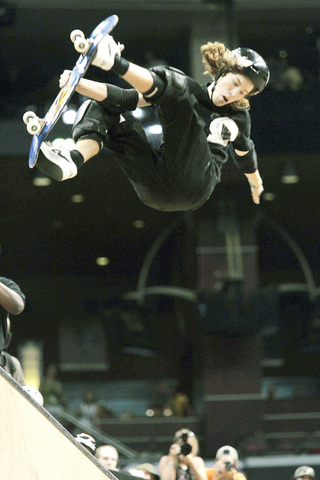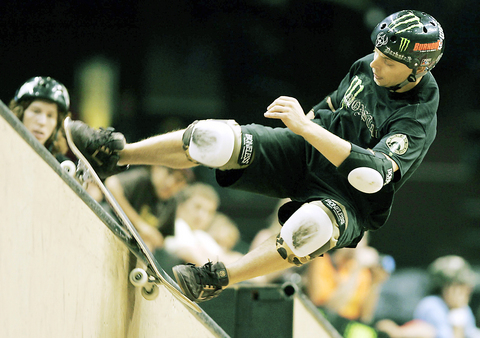Shaun White, 18, had won the silver medal in the skateboard vert event at the X Games, and he was describing what it is like to ride against competitors who are mostly 10 years older. "It will get you a little hazing, for sure," he said.
White, who is a professional snowboarder with seven Winter X Games medals, won his first Summer X Games medal Friday night with a hard-charging opening run that included a body varial front side 540, a new trick that only he has executed.
But White is a board-sports prodigy able to excel against more experienced competition. The average age of the other competitors in the skateboard vert event was 29. The gold-medal winner, Pierre Luc Gagnon, at 25, is closest to White in age, and the bronze medalist, Sandro Dias, is 30.

PHOTOS: NY TIMES
It was a similar situation in the BMX freestyle vert event Thursday night, where the average age was 31. The winner, Jamie Bestwick, is 34, and the bronze medalist, Kevin Robinson, is 33.
By comparison, the average skateboard street competitor is 24.
One of the main reasons the vert -- short for vertical -- riders tend to be older is because of the level of experience required on the large ramps used at major contests. Yet other factors are at play, including a lack of younger skaters and bikers to challenge the established athletes.

"About 95 percent of skateboarders worldwide are not vert riders," said Dave Duncan, a former professional skater and an announcer at the X Games. "They don't have vert ramps around. It's easier to ride the streets."
"To be a vert guy, you have to train and put on your gear," Duncan added. "It's physically demanding."
During the late 1970s and throughout the 1980s, vert riding ruled skateboarding and BMX. Tony Hawk epitomizes the vert discipline for skateboarding. But a trend toward street riding began to take hold around 1990, and most children abandoned ramps.

"As an organizer it concerns me," said Steve Swope, a former professional BMX rider, and the president of the US BMX Freestyle Federation, a new national governing body for the sport. "I remember the days in the 1980s when there were 50 pros on the deck and 80 amateurs. In the latest contests, there have been seven amateurs -- that's normal."
Vert remains a viewer-friendly format for television, however. And although those featured on ESPN's telecasts are at the top of their game, they are mostly the same athletes who began during the ramp-riding boom of 20 years ago.
White is the exception. He skates regularly on a halfpipe at the YMCA in Encinitas, California, and said that he seldom saw younger skaters there. Still, he does not worry about succession. "There's always going to be somebody to come up and take the throne," he said.
Swope, too, described succession in BMX as organic. "Once the older guys retire, newer guys will move up to take their place," he said.
Still, he and others are not waiting for it to happen. Instead, they are implementing measures to enable more youngsters to get involved in vert riding.
Gary Ream is the co-owner of Camp Woodward, an action sports training center and summer camp near State College, Pennsylvania. He is also the vice president of the BMX federation and the president of USA Skateboarding. Through his work at Woodward, Ream is probably responsible more than anyone else for nurturing up-and-coming rippers.
"My goal is to have a grass-roots program," Ream said. "We know the numbers in skateboarding are better than Little League."
In a move that will make action sports more like Little League, the governing bodies for skating and BMX plan to implement contest series culminating in national championships during the next year, including vert.
Ream has also recognized that the 4m-tall ramps that the pros ride are overwhelming to youngsters who are only getting started, so he had a 3m halfpipe built.
"I started on a 12-foot (3.7m) vert ramp," said Koji Kraft, who at 22 is the youngest BMX freestyle vert rider at the X Games. "It was intimidating."
Given the danger of falling on a huge vert ramp, many opt instead for the street, according to Kraft. "Crash on street and you could be back two days later," he said. "One crash on vert could take you out for a year."
Added Kagy: "It doesn't matter how good you are, eventually you are going to slam. Vert's a darn scary thing. You could fall off the top of the ramp and get hurt. Now try going 13 feet (4m) above that."
All of which will continue to make vert riding the exclusive domain of the bold. For those willing to try, however, there will soon be more opportunities to ride ramps.
"This is something we've thought about for the past five years," Swope said. "We're going to have some new blood come along. No question -- there's talented riders out there who can ride vert."

On April 26, The Lancet published a letter from two doctors at Taichung-based China Medical University Hospital (CMUH) warning that “Taiwan’s Health Care System is on the Brink of Collapse.” The authors said that “Years of policy inaction and mismanagement of resources have led to the National Health Insurance system operating under unsustainable conditions.” The pushback was immediate. Errors in the paper were quickly identified and publicized, to discredit the authors (the hospital apologized). CNA reported that CMUH said the letter described Taiwan in 2021 as having 62 nurses per 10,000 people, when the correct number was 78 nurses per 10,000

As we live longer, our risk of cognitive impairment is increasing. How can we delay the onset of symptoms? Do we have to give up every indulgence or can small changes make a difference? We asked neurologists for tips on how to keep our brains healthy for life. TAKE CARE OF YOUR HEALTH “All of the sensible things that apply to bodily health apply to brain health,” says Suzanne O’Sullivan, a consultant in neurology at the National Hospital for Neurology and Neurosurgery in London, and the author of The Age of Diagnosis. “When you’re 20, you can get away with absolute

May 5 to May 11 What started out as friction between Taiwanese students at Taichung First High School and a Japanese head cook escalated dramatically over the first two weeks of May 1927. It began on April 30 when the cook’s wife knew that lotus starch used in that night’s dinner had rat feces in it, but failed to inform staff until the meal was already prepared. The students believed that her silence was intentional, and filed a complaint. The school’s Japanese administrators sided with the cook’s family, dismissing the students as troublemakers and clamping down on their freedoms — with

As Donald Trump’s executive order in March led to the shuttering of Voice of America (VOA) — the global broadcaster whose roots date back to the fight against Nazi propaganda — he quickly attracted support from figures not used to aligning themselves with any US administration. Trump had ordered the US Agency for Global Media, the federal agency that funds VOA and other groups promoting independent journalism overseas, to be “eliminated to the maximum extent consistent with applicable law.” The decision suddenly halted programming in 49 languages to more than 425 million people. In Moscow, Margarita Simonyan, the hardline editor-in-chief of the